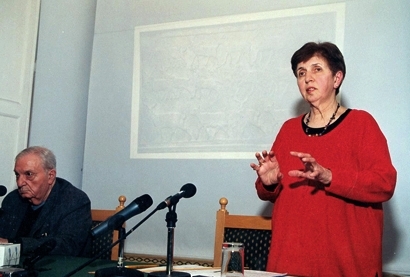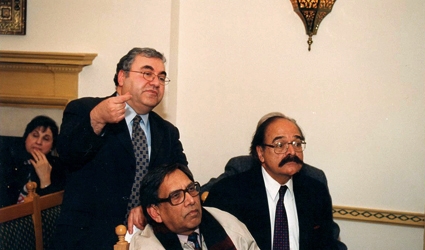Dr Lamia al-Gailani gave a lecture at Eagle House on the evening of Wednesday 27th February 2002 on “The First Arabs in the Fertile Crescent” as part of Al-Furqan Islamic Heritage Foundation’s series of public lectures.
The lecture began with a summary of the political situation in the Fertile Crescent in approximately the 8th century BC. Dr al-Gailani introduced the people of the region to her audience: the Arameans in the Levantine desert, who had established a number of independent city states in Damascus, Aleppo and Hama but did not have a unified state; in the south, Pharaonic Egypt was weak and threatened by the Libyans who had invaded from the west and set up a state in the Nile delta while the Sudanese had invaded from the south and established their own state in Upper Egypt.

The Assyrians were the de facto power in Iraq. But since their country lacked raw materials, especially ornamental materials such as gold and ivory, the Assyrian kings sought to protect and secure trade routes by invading and controlling neighbouring lands and guaranteeing the allegiance of their peoples through treaties, pacts and the imposition of tribute.
The Assyrians recorded their events and daily concerns in both written and carved form. They were also famed for the cities they built as centres of their empires such as Ashur, Nimrud and Nineveh, where they constructed opulent palaces filled with furniture and artefacts encrusted with gold and ivory.
The first reference to the Arabs in history appears in an Assyrian record written during the reign of King Shalmaneser III who, when campaigning against the Syrian city states, confronted an alliance between them and King Jandab, an Arab king who took part in a battle near Aleppo with a force of ten thousand camels. From this first reference onwards the Arabs were associated with great wealth and fortune. The Hebrews were also mentioned for the first time in history in the same archaeological record, along with Ahab their king. This demonstrates clearly that Arabs and Hebrews were both present in the region at the same time.

The Assyrian kings fought the Arabs in many battles. They also used many other means to subjugate them, such as controlling their >water supplies, displacing some Arab tribes and changing trade routes in an attempt to undermine their power. These tactics led to the dispersal of the Arabs into present-day Syria and Iraq. After some battles, the Assyrians recorded taking booty and captive Arab queens back to Mesopotamia. They also resorted to the new tactic of returning a captured Arab queen to her throne under a guardian who supervised her and ensured her loyalty, thus controlling the Arabs by dealing with them through her. They developed this tactic further by taking the sons and daughters of Arab kings to Assyrian capitals, where they would be instructed and “Assyrianised’ before being returned to their native lands to govern the Arabs.
Assyrian records refer to the names of various Arab kings and queens, including King Khazal, leader of the Qidar tribes in Dawmah al-Jandal in the Wadi Sirhan valley which was an important religious centre. They also mentioned the names of two queens: Shimsi and Zubaydah.
Dr al-Gailani illustrated her lecture by showing a number of slides of Assyrian carvings, stele and palaces.
At the end of her informative lecture there were many questions for Dr al-Gailani from members of the audience.

Dr al-Gailani is an academic specialising in research into the Babylonian civilisation. She has worked in the Iraqi Museum and participated in archaeological excavations in Mesopotamia. She has also published a number of scientific works.

